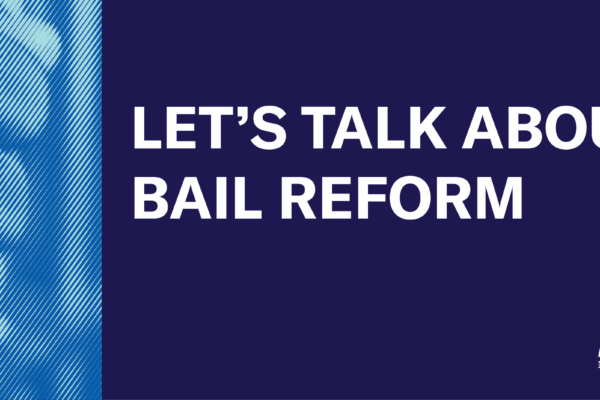We want to clear up a few things about what “bail reform” is, what it does, and why it’s important to all Granite Staters. Misinformation is being spread, and it’s vital that we discuss the facts.
“Bail reform” is the law that transformed the bail system in New Hampshire. It was originally enacted in 2018, and modified in 2019. Its purpose is two-fold: to (1) prevent people from being jailed before trial simply because they could not afford bail, even $100 bail; and (2) give law enforcement and prosecutors a tool for detaining people pre-trial without bail if they are dangerous to themselves or others.
This comprehensive reform was a major victory for the New Hampshire justice system, which has since seen a decline in the number of people who, although presumed innocent, are being jailed before they even have a trial.
PART 1: THE CASH BAIL SYSTEM
The original bail system was created as a financial incentive mechanism. A judge would impose a bail amount, which varied depending on the charges,which was supposed to make sure that people return to court for trial. They would pay the bail, be able to go home, and then get the bail money back when they returned for their court date. This meant that people with money could buy their freedom as they awaited their trial. But what about people that didn’t have the money?
Under the old bail system, on any given day in New Hampshire, hundreds of people sat in jail even though they were presumed innocent—simply because they couldn’t afford the bail amount—even if it was $100.
Here’s an example that illustrates why exactly this is unfair and unjust: Say two people are arrested for each allegedly stealing a sweatshirt. The judge sets bail at $500. What happens next?
- Person A pays the $500 bail, goes home, and returns in a few months for their court date.
- Person B, however, cannot afford the $500 bail, so they sit in jail (for months or longer) until their court date, during which time they might lose their job, which means they wouldn’t be able to pay rent, which means they might get evicted. (And, if person B was later acquitted or the charges against them were dropped, the state did nothing to make them whole again. So they would leave jail unemployed and without housing.)
Now enter bail reform. The new, reformed, system prevents bail from being set at an amount that Person B cannot afford and would result in their detention before trial. Why? Because Person B should not sit in jail for months simply because they cannot pay bail. Bail was never designed to hold people for months and months before trial because they are poor. It was meant to be an incentive for people to return to court, but that only works if the person is released pre-trial.
PART 2: BAIL REFORM DOES EVEN MORE
Some have complained that bail reform could let too many “dangerous” people out before trial, but there’s actually a built-in solution for that. The new bail laws have a new feature that the old one did not: with bail reform, any person can be detained pre-trial without bail if they are a clear danger to themselves or others. The old system didn’t have that: previously, you could only detain someone without bail if they were charged with a narrow subset of domestic violence charges. So, if the court wanted to detain someone because they were dangerous, the court had to rely on setting really high bail in hopes that the person couldn’t afford it. This didn’t always work, and it’s a misuse of bail. Bail reform fixed this by allowing anyone that is clearly dangerous to be held without bail.
How this works is the state presents evidence that someone is a danger to themselves or others and therefore should be detained without bail before trial. The judge weighs the evidence and makes that decision—not the police. And yes, prosecutors have to prove dangerousness by clear and convincing evidence, which is a constitutionally-required standard. As a society, we should demand nothing less if the government is to deny someone their liberty before they’ve been convicted.
The decision to jail someone before their trial is serious. It can’t be based on bias, assumption, or speculation. Just because someone is experiencing homelessness or struggling with a substance use disorder or has a mental illness does not necessarily make them dangerous. And jailing them certainly does not solve what they are going through.
PART 3: PEOPLE EXPERIENCING HOMELESSNESS OR SUBSTANCE USE DISORDERS
Some complaints have increasingly inferred that the problem with bail reform is that it prevents the jailing of people before trial who are homeless, poor, have a mental illness, or struggle with a substance use disorder. Let’s be clear: Incarceration is the solution to absolutely none of those social issues.
Our jails are ill-equipped to help people suffering from substance use disorders. Cases of people who are released before trial and then overdose are tragedies, but they are not examples of bail reform failing. They are cases of failing social services, the realities of an opioid epidemic, and a state needing to do more to respond to the medical crisis that is addiction.
We cannot incarcerate our way out of social problems. Jailing a homeless person will remove the person from the park temporarily, but it does not solve their homelessness nor the reasons for it. More importantly, it is an injustice to use our criminal justice system to hide those we are embarrassed about or uncomfortable with in our communities.
The current bail system treats all people equally, because they are all presumed innocent. Rather than determining whether someone should be detained based on their bank account, it looks at what’s most important: whether they are a danger to themselves or others.
Bail reform is working, and we need to talk more about it.

